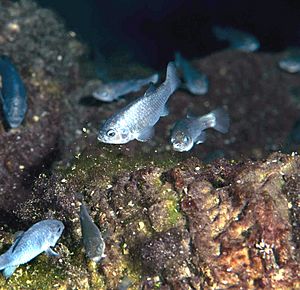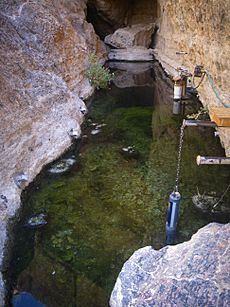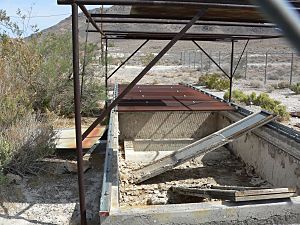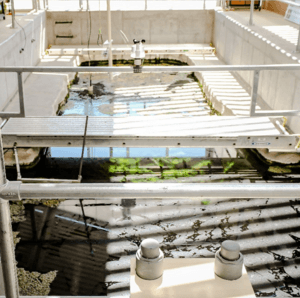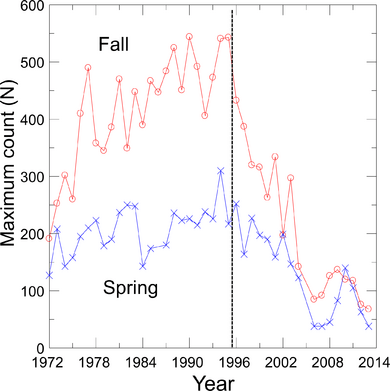Devils Hole pupfish facts for kids
Quick facts for kids Devils Hole pupfish |
|
|---|---|
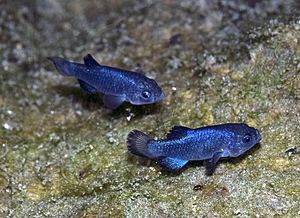 |
|
| Conservation status | |
| Scientific classification |
The Devils Hole pupfish (Cyprinodon diabolis) is a very rare fish. It is listed as critically endangered, meaning it is at high risk of disappearing forever. This special fish lives only in one place: Devils Hole, a water-filled cave in Nevada, USA.
Scientists first described this fish in 1930. It is a small fish, growing up to about 30 millimeters (1.2 inches) long. Male pupfish are bright metallic blue, while females and young fish are more yellow. A unique feature of this fish is that it does not have pelvic fins.
Devils Hole pupfish eat almost everything available in their home, including tiny beetles, snails, algae, and small freshwater creatures. Their diet changes throughout the year. A beetle called Neoclypeodytes cinctellus sometimes eats the pupfish's eggs and young.
These fish reproduce all year, with more babies born in spring and fall. However, females lay only a few eggs, and not many young fish survive to become adults. Most Devils Hole pupfish live for about 10 to 14 months.
Devils Hole is over 130 meters (427 feet) deep, but the pupfish only live in the top 24 meters (80 feet). The water stays at a constant warm temperature of 33°C (91°F), and there isn't much oxygen. A small, shallow rock shelf is very important for the pupfish to find food and lay eggs.
In the 1960s and 1970s, nearby farms used a lot of water for irrigation. This caused the water level in Devils Hole to drop, making the important shelf smaller. This led to several court cases. The Supreme Court decided that protecting Devils Hole as a National Monument also meant protecting enough groundwater for the fish. Other dangers to the pupfish include sudden floods, earthquakes, and even people causing damage.
Because the pupfish lives in only one spot, people have tried to create other populations since the 1960s. Most of these attempts failed. In the early 2010s, a perfect copy of the top 6.7 meters (22 feet) of Devils Hole was built at a special facility. Scientists put eggs from Devils Hole into this new home.
Efforts to protect the wild pupfish include removing dirt from the shallow shelf, adding extra food, and putting up fences and cameras to keep unauthorized people away. Saving the pupfish has been expensive and has caused disagreements. Some people believe the fish should be allowed to die out, while others say it would be like destroying a famous museum for a parking lot.
Scientists count the pupfish twice a year, in spring and fall. The fall count is usually much higher. Since 1972, the highest count has been around 550 fish. In April 2013, only 35 fish were counted, but the number grew to 136 by spring 2019. The Devils Hole pupfish has been listed as endangered by the US government since 1967. The International Union for Conservation of Nature (IUCN) has listed it as critically endangered since 2014.
Contents
Understanding the Devils Hole Pupfish
How Scientists Named and Classified This Fish
The Devils Hole pupfish was officially named a new species in 1930 by an American fish expert named Joseph H. Wales. He collected the first fish samples from Devils Hole in Nevada. The name "diabolis" comes from "Devils Hole," where the fish lives.
Scientists use taxonomy to group living things. Genetic studies show that the Devils Hole pupfish is most closely related to Cyprinodon nevadensis. These two, along with the Death Valley pupfish (C. salinus), form a group of fish found in the Amargosa River basin.
How Old is the Devils Hole Pupfish?
Scientists are still debating how old this fish species is. Devils Hole itself formed about 60,000 years ago. Some researchers think the pupfish has lived there alone for 10,000 to 20,000 years. No one knows for sure how the fish first got into Devils Hole. Some ideas include them swimming through underground water or even being carried there by Native Americans, who used pupfish as food.
Other studies, using genetic information, suggest the species might have arrived in the last 1,000 years. However, another study suggests it could be as old as 60,000 years. These different ideas depend on how fast the fish's genes change over time, which is hard to know for sure.
What Does the Devils Hole Pupfish Look Like?
The Devils Hole pupfish is the smallest type of pupfish. It grows to about 30 mm (1.2 inches) long, with an average length of 23 mm (0.9 inches).
Male and female pupfish have different colors:
- Males are dark brown with shiny metallic blue sides. Their fins have black edges, and their backs look golden. Their gill covers are violet and shiny. Their eyes are also blue and shiny.
- Females and young fish are more yellow. Their backs are yellowish-brown, and their pectoral and tail fins have yellow edges. Their gill covers are metallic green, and their eyes are metallic blue. Young fish have a faint vertical bar on their sides.
A unique feature of this fish is that it does not have pelvic fins, which are usually found on other fish. Its dorsal fin has twelve rays, and each pectoral fin has seventeen rays. The tail fin is rounded and has twenty-eight rays. The fish has 27 scales along its side, and these scales have small teeth on their outer edges.
Life and Environment of the Pupfish
What Do They Eat?
The Devils Hole pupfish eats many different things found in Devils Hole. This includes tiny bits of rock, algae like Spirogyra and diatoms, small freshwater creatures, and even tiny snails. What they eat changes with the seasons:
- Spring (March-May): Mostly tiny rock bits, diatoms, and Spirogyra algae.
- Summer (June-August): Mostly tiny rock bits, Spirogyra, and diatoms.
- Autumn (September-November): Mostly tiny rock bits, Spirogyra, and a small freshwater creature called Hyalella azteca.
- Winter (January-February): Mostly tiny rock bits, diatoms, and tiny crustaceans called ostracods.
Scientists think the fish might eat tiny rock bits by accident when they feed at the bottom or surface of the water. They also think that Spirogyra might be more of a place for the fish to look for food, rather than a main food source itself.
Who Eats the Pupfish?
A type of diving beetle called Neoclypeodytes cinctellus eats the eggs and young pupfish. This beetle also eats some of the same small creatures as the pupfish, so it competes with them for food. This diving beetle is a new part of the Devils Hole ecosystem, first seen there in 1999 or 2000.
How Do They Reproduce?
Devils Hole pupfish lay eggs all year round. They lay the most eggs from mid-February to mid-May, with another smaller peak from July to September. Sometimes, they lay eggs at unusual times, like after an earthquake shakes their home.
During spawning, several male pupfish chase a female until she is ready to lay an egg. Then, one male swims next to her, and she lays a single egg, which the male immediately fertilizes. These eggs are only about 1 mm (0.04 inches) wide. Female pupfish do not produce many eggs, and not many eggs hatch or survive to become adult fish. Pupfish usually live for 10 to 14 months.
Where Do They Live in Devils Hole?
Devils Hole is a water-filled cave in the Amargosa Desert in Nevada, USA. It is part of the Amargosa River's underground water system. The cave is about 22 meters (72 feet) long and 3.5 meters (11.5 feet) wide. It is at least 130 meters (427 feet) deep. Devils Hole is considered one of the smallest places on Earth that holds an entire population of a vertebrate species.
The water in Devils Hole is always around 33°C (91°F). There is a small rock shelf about 0.3 meters (1 foot) deep at one end of the hole. This shelf is about 3.5 by 5 meters (11.5 by 16.4 feet) in size. The amount of oxygen in the water is low, but the shallow shelf can have more oxygen in summer.
Even though pupfish have been found as deep as 24 meters (80 feet), most of them live closer to the surface, especially above 15 meters (49 feet) deep. They rely on the shallow shelf for laying eggs and for most of their food, which is mainly diatoms (a type of algae).
Natural events like flash floods and earthquakes can disturb this delicate home. However, in the 1960s and 1970s, the biggest threat was too much groundwater being pumped out for farming. This caused the water level to drop.
Research shows that the number of pupfish changes each year based on how much algae grows on the shallow shelf. Algae growth depends on sunlight and nutrients. Nutrients might increase when barn owls use the cave as a roost, as their droppings fall into the water.
Protecting the Devils Hole Pupfish
What Harms the Pupfish?
The Devils Hole pupfish is very sensitive to changes because it lives in only one place. In the 1970s, pumping too much groundwater lowered the water level in Devils Hole. This made it hard for the fish to lay eggs on the shallow shelf. After groundwater pumping was limited, the fish population grew back. However, it started to decline again after 1995 for unknown reasons. Scientists think it could be due to issues like too much inbreeding (when closely related individuals reproduce), a loss of food sources, or changes in the algae and tiny creatures they eat.
Future threats could include climate change. Warmer temperatures might shorten the best time for young fish to grow into adults. Large earthquakes can cause big waves, called seiches, in Devils Hole. These waves can make the fish lay eggs at unusual times and can also wash away the algae they eat. Flash floods can also bring debris into Devils Hole, harming the algae.
People can also harm the pupfish. In 2004, a flash flood washed scientific equipment into Devils Hole, killing about eighty pupfish. In April 2016, three men broke into the protected area. They damaged scientific equipment, walked on the shallow shelf, and destroyed pupfish eggs and young. They also vomited into the water.
How Laws and Courts Protect Them

In the late 1940s, a fish expert named Carl Leavitt Hubbs started working to protect Devils Hole and its pupfish. This led to President Harry S. Truman declaring Devils Hole part of Death Valley National Monument in 1952. In 1967, the pupfish was officially listed as an endangered species. This made it one of the first species protected under the Endangered Species Act.
In the late 1960s, a company bought land near Devils Hole to create farms. They drilled many wells, which caused the water level in Devils Hole to drop. This was a big problem because the shallow shelf, where the fish feed and lay eggs, was shrinking. People became very concerned about saving the pupfish. Some said letting it die out would be like "bombing the Louvre to make way for a parking lot."
In 1971, the US government sued the company to stop them from pumping water. The government argued that when Devils Hole became a National Monument, it also meant protecting the water needed for the fish. The case went all the way to the Supreme Court.
In 1976, the Supreme Court decided in favor of the pupfish. They ruled that the water needed to keep the pupfish alive was protected. In 1977, a lower court set a minimum water level for Devils Hole.
Later, in 1980, the U.S. Fish and Wildlife Service (USFWS) marked about 21,000 acres (8,500 hectares) as important habitat. This area was where groundwater most affected Devils Hole. The goal was to keep the water levels stable so the pupfish population could grow.
In 1980, a company bought more land near Devils Hole, planning to build many homes. This raised concerns about water use again. To protect the area, a non-profit group called The Nature Conservancy bought the land in 1984. They then transferred it to the government, creating the Ash Meadows National Wildlife Refuge. By 1986, a plan was made to help all the endangered species in Ash Meadows, including the Devils Hole pupfish.
As of 2014, the IUCN still lists the Devils Hole pupfish as critically endangered. This is because it lives in a very small area, in only one place, and has a very small population, often fewer than 100 adult fish.
What is Being Done to Help Them?
Protecting the Wild Fish
Soon after 1956, a locked gate was put at Devils Hole to stop people from entering. In 2005, some dirt was removed from the shallow shelf to help the fish feed and lay eggs. While more young fish appeared, the overall population still went down. In 2006, biologists started giving the fish extra food because they looked unhealthy. After people damaged the site in 2016, the National Park Service added more barbed wire to the fences and installed more motion sensors and video cameras.
Creating Safe Homes Outside Devils Hole
Because people worried the pupfish might disappear from Devils Hole, efforts were made to create other populations outside their natural home. This is called ex situ conservation. Some early attempts to move fish to nearby springs failed quickly. Attempts to keep them in aquariums also failed.
Several artificial "refuges" were built, like concrete tanks that tried to copy the conditions in Devils Hole. One was built in 1972 near the Hoover Dam. It held hundreds of fish for several years. However, problems with the water system in 1985 and 1986 killed most of the fish.
Two more refuges were built at the Ash Meadows National Wildlife Refuge in 1973 and 1990. Unfortunately, maintaining these refuges was difficult. The small number of fish used to start these populations caused problems. Also, in one refuge, closely related fish with pelvic fins (which Devils Hole pupfish don't have) accidentally got in and bred with the pupfish. This created hybrid fish. By 2007, all these older refuges had failed.
In the early 2010s, a new and much better refuge was built at the Ash Meadows Fish Conservation Facility (AMFCF). This new tank is a full-size copy of the top 6.7 meters (22 feet) of Devils Hole. It has similar water chemistry, a spawning shelf, and natural sunlight. However, it is kept a bit cooler and has more oxygen to reduce stress on the fish.
This new refuge has at least 50 captive pupfish, with more in separate breeding tanks. Eggs laid in the refuge tank are raised in a different tank until they are adults. Scientists try to remove the predatory beetle Neoclypeodytes cinctellus from the captive tank to protect the eggs.
The pupfish population at AMFCF was started by taking eggs from Devils Hole. Scientists only remove eggs during winter, when they are less likely to grow into adults in the wild. This way, taking the eggs has the least impact on the wild population. The eggs are treated to prevent fungus, bacteria, and parasites. They are then raised in aquariums until they are adults and moved to the large refuge tank.
How Much Does It Cost and What Do People Think?
Millions of dollars have been spent to save the Devils Hole pupfish. The Ash Meadows Fish Conservation Facility alone cost about $4.5 million to build. Some people argue that saving the pupfish is too expensive.
The legal battle over groundwater extraction was very intense. The family who owned the ranch and invested a lot of money could no longer pump as much water. Their lawyer said the Supreme Court chose a fish over people. A newspaper editor even threatened to put poison in Devils Hole to kill the fish. In response to "Save the Pupfish" bumper stickers, some people made "Kill the Pupfish" stickers. The family eventually sold their ranch.
How Many Pupfish Are There?
Scientists have been counting the Devils Hole pupfish since 1972 using the same methods. Divers count fish deep in the water, while other researchers count fish on the shallow shelf. From 1970 to 1996, the average population was 324 fish. The highest counts were around 541-548 fish in 1980, 1990, and 1995.
Since 2005, the population in Devils Hole has been below 200 fish. The number of fish changes with the season. In spring, the population is usually much smaller (35-65% of the autumn population) because there is less algae growth and other difficult winter conditions. The reasons for the overall decline are not fully clear. A 2014 study estimated that the Devils Hole pupfish had a 26-33% chance of becoming extinct in the next twenty years.
In November 2005, only 84 fish were counted. In 2007, there were only 38 to 42 fish left. However, the count rose to 126 in autumn 2008, which was the first steady increase in over 10 years. In April 2013, only 35 fish were counted, but this number increased to 92 in 2014. By spring 2016, 115 fish were counted. In spring 2019, the pupfish population reached 136, the highest spring count since 2003.
Images for kids
See also
 In Spanish: Pez cachorrito del Hoyo del Diablo para niños
In Spanish: Pez cachorrito del Hoyo del Diablo para niños



